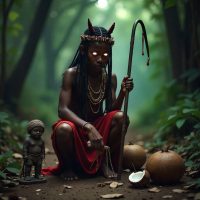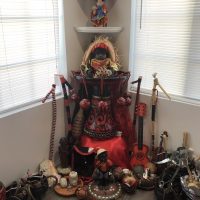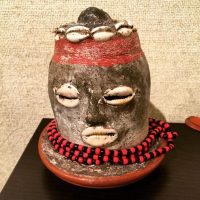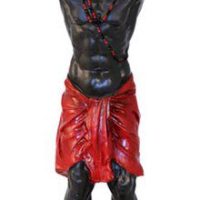Elegguá : The Orisha Who Opens Roads and Shapes Destiny
Listen
At a glance
| Description | |
|---|---|
| Origin | Santeria Mythology |
| Classification | Gods |
| Family Members | N/A |
| Region | Cuba |
| Associated With | Trickster, Destiny, Fate |
Elegguá
Introduction
Elegguá is one of the most essential and powerful orishas in Santería, with origins rooted in Yoruba spirituality from West Africa. Transported to the Americas through the transatlantic slave trade, he evolved into a central figure across Afro-Caribbean religions, including Cuban Santería, Brazilian Candomblé, Haitian Vodou, and various diasporic practices. Elegguá governs beginnings, choices, and the unfolding of destiny, embodying the energies that guide life’s turning points. He stands at the crossroads—literal and symbolic—deciding which opportunities appear, which paths close, and how spiritual communication flows. Revered as the first orisha created by Olodumare, he must always be honored before any ritual or divination, for nothing proceeds without his permission. His playful, unpredictable, yet protective nature makes him one of the most dynamic and influential deities in the Yoruba-diasporic pantheon.
Physical Traits
Elegguá’s physical representation changes depending on his “camino,” or spiritual path, but all forms express his dominion over beginnings, movement, and fate. He may appear as a mischievous child full of energy and curiosity, or as a wise old man who has mastered every road. His colors—red and black—represent his dual forces of creation and disruption, life and death, clarity and mystery. In many homes and shrines, Elegguá is depicted as a small stone head or cement figure adorned with cowrie shells for eyes and mouth, reinforcing his role as a vigilant guardian who sees all that passes. He is closely associated with keys, whistles, and a shepherd’s crook, tools that symbolize his authority over gateways and transitions. Candies, cigars, and coconuts are common offerings, reflecting both his youthful vitality and his ability to wield immense spiritual power.
Family
Elegguá’s lineage varies across Yoruba and diaspora traditions, but he is universally recognized as one of the elder or primordial orishas. In some accounts, he is considered a child of Obatalá and Yemayá, while in others he exists before the formation of the world, emerging directly from Olodumare’s divine essence. He maintains close alliances with the warrior orishas—Ogun and Ochosi—with whom he forms the powerful group known as the Guerreros (Warriors). Elegguá also maintains a significant spiritual relationship with Orunmila, the orisha of wisdom and divination; together they guide the destinies of humans. Although he is sometimes merged or contrasted with Eshu, the Yoruba messenger deity, Santería typically distinguishes Elegguá as the more approachable and protective manifestation, while Eshu retains a wilder, more volatile nature. His complex relational network reflects the interconnectedness and layered identities of the orishas across cultures.
Other names
Elegguá is known by multiple names across regions, languages, and religious traditions, each highlighting different aspects of his character. In Yoruba spirituality, he is commonly known as Eshu, a messenger and sacred trickster. Variants such as Elegba and Elegbara emphasize his authority and expansive power. In Haitian Vodou, he appears as Papa Legba, a wise, cane-bearing gatekeeper who opens communication between the living and the spirits. In Brazil, he is recognized as Exu, a fiery and transformative force within Candomblé and Umbanda. Through Catholic syncretism in Cuba, Elegguá is associated with the Santo Niño de Atocha, whose youthful form mirrors Elegguá’s childlike aspects. He is also said to have 101 different “caminos,” each representing a unique personality, function, or domain, demonstrating the immense breadth of his influence across the spiritual world.
Powers and Abilities
As master of crossroads, Elegguá holds unparalleled authority over all beginnings, choices, and outcomes. His primary power lies in opening and closing the roads of life, influencing luck, opportunity, and access to spiritual help. He governs entrances, doorways, and thresholds—the spaces where one reality transforms into another. Elegguá is also the divine messenger, carrying prayers to the higher orishas and relaying their responses. No ritual, offering, or divination can succeed without invoking him first, as he alone controls the flow of aché (divine energy). His trickster nature, while sometimes misunderstood, serves as a profound spiritual teacher. Through playful mischief or sudden challenges, he exposes truth, tests character, and pushes individuals toward growth. Elegguá is also protector of children and travelers, watching over those who face new beginnings or uncertain paths. His influence over destiny makes him both a benevolent guide and a force that must be treated with respect.
Modern Day Influence
Elegguá remains deeply embedded in contemporary spiritual and cultural practices throughout the Caribbean, Latin America, and North America. His image is commonly found at doorways of homes and businesses, where he is believed to guard against misfortune and usher in prosperity. In cities like Havana, Miami, Salvador da Bahia, and New York, his colors, symbols, and altars appear in artwork, jewelry, and public murals, reflecting his enduring presence in modern identity and cultural expression. Scholars of religion, anthropology, and African diaspora studies frequently examine Elegguá’s role as a symbol of resilience, cultural survival, and spiritual adaptation. In popular culture, he inspires characters in literature, music, and film, often representing choice, chaos, transformation, and the mysteries of fate. Digital spirituality has also embraced him, with devotees establishing virtual altars and invoking him in online communities. Elegguá continues to evolve while remaining rooted in the traditions that have honored him for centuries.
Related Images
Source
About Santeria. (n.d.). Eleguá/Eshu. Retrieved from http://www.aboutsanteria.com/eleguaacuteeshu.html
Santeria Church. (2012, June 26). Eleggua. Retrieved from http://santeriachurch.org/the-orishas/eleggua/
Wikipedia. (2006, May 29). Elegua. Retrieved from https://en.wikipedia.org/wiki/Elegua
Original Botanica. (2024, June 27). Elegua: Orisha of the Crossroads. Retrieved from https://originalbotanica.com/blog/the-orishas-elegua
Xotic Brands. (n.d.). How Elegua is the God of Crossroads, Beginnings and Opportunities. Retrieved from https://www.xoticbrands.net/blogs/news/elegua
Oshaeifa.com. (n.d.). Elegua: Who it is, Characteristics, History and More. Retrieved from https://en.oshaeifa.com/orisha/elegua/
Postposmo. (n.d.). Meet Eleguá: characteristics, rites, prayers, qualities and more. Retrieved from https://en.postposmo.com/elegua/
Murphy, J. M. (1994). Santería: African Spirits in America. Beacon Press.
Barnet, M. (1997). Afro-Cuban Religions. Markus Wiener Publishers.
Thompson, R. F. (1983). Flash of the Spirit: African and Afro-American Art and Philosophy. Vintage Books.
Mason, M. (2002). Living Santería: Rituals and Experiences in an Afro-Cuban Religion. Smithsonian Institution Press.
Olmos, M. F., & Paravisini-Gebert, L. (2003). Creole Religions of the Caribbean: An Introduction from Vodou and Santería to Obeah and Espiritismo. NYU Press.
Frequently Asked Questions
Who is Elegguá in Santería?
Elegguá is the orisha of crossroads, beginnings, choices, and destiny. He is the gatekeeper who must be honored before any ritual or communication with other orishas.
What does Elegguá represent?
He represents the opening and closing of life paths, the flow of spiritual energy, and the unpredictable yet vital forces that shape fate.
What offerings are commonly given to Elegguá?
Traditional offerings include candies, cigars, rum, coconuts, and toys, depending on which of his paths or “caminos” is being honored.
Is Elegguá the same as Eshu or Papa Legba?
They share origins and similar roles, but each tradition interprets them differently. Elegguá is the Santería manifestation, while Eshu belongs to Yoruba religion and Papa Legba appears in Haitian Vodou.
Why is Elegguá honored first in rituals?
He controls communication with the divine and the movement of spiritual energy. Without his permission, no ritual can proceed successfully.








